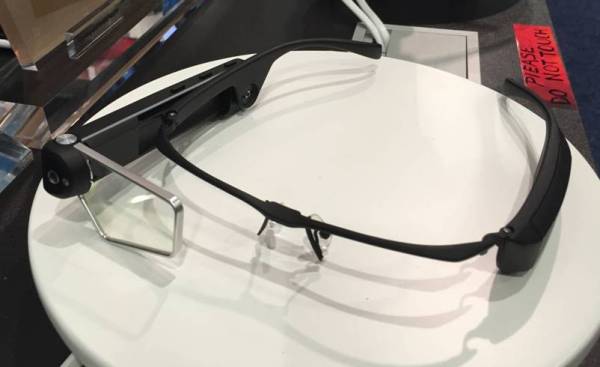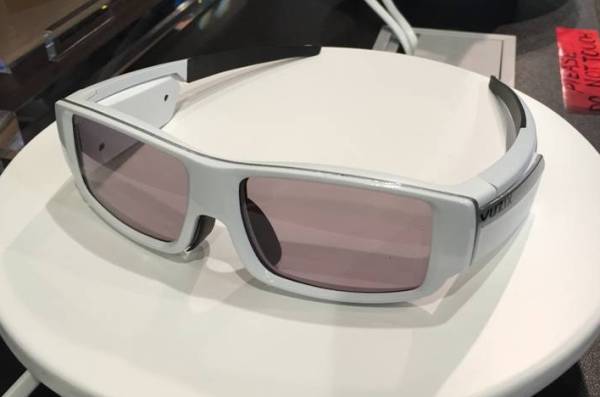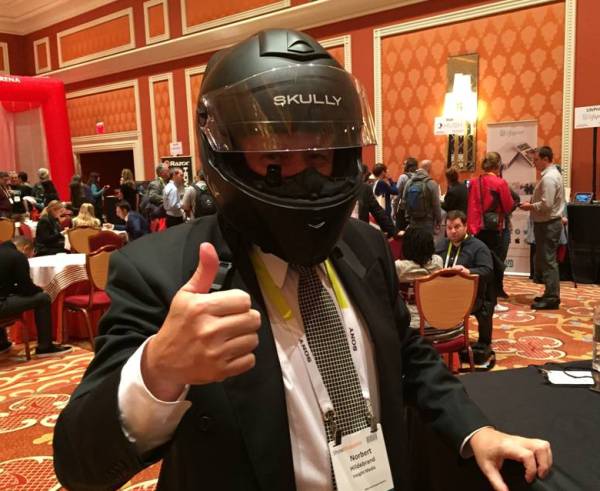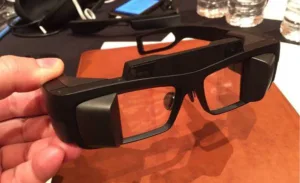Lumus Optical, the Israel-based developer showed their latest LCOS based DK 50 binocular AR device as well as some older models for comparison. Unlike other technologies, they couple their image into a planar waveguide that is not based on holographic coatings. Instead they carefully the couple the image into the glass plate that has semi reflective surface embedded in the waveguide, where the AR content is reflected into the eye. At the same time you can also see through the mirror areas as is expected for AR glasses. The design is based on fused glass sheets that are then cut under a precise angle to create the planar waveguides. As a consequence, the waveguide creates the wide field of view, especially in the vertical direction. In the current implementation, the vertical field of view is the complete height of the waveguide, while the horizontal field is determined by the number of reflective surfaces. This results in a diagonal field of view of about 40 degrees at a maximum brightness of 1,200 footlambert.
They make the waveguides in house with newly installed manufacturing capacity, which can make production runs in the tens of thousands for 2016. They plan to run hundreds to thousands of units of the DK 50 device in Q2 of 2016 as samples for enterprise customers. They agree that the current AR devices are not ready for consumers, but it will be possible to use them for enterprise applications.
They are also working on a prototype with a 60 degree field of view that will be available later in 2016. While they make the waveguide for now in house they plan to use outside manufacturers once they go into mass production. In the current form, the DK 50 will retail for about $3,000, certainly too high for a consumer product.
As it seems to be a yearly event, Vuzix won a design prize for their iWear Video Headphones, a new wireless video headset similar to the Zeiss Cinemizer and the Sony Personal 3D Viewer. In contrast to these two older models the Vuzix device includes circumaural headphones similar to devices like the Glyph and Royole. The Vuzix headset comes with two 720p imagers and creates a 55 degree field of view in the diagonal which equates to watching a 125” screen at a distance of 10 feet (3m). On the video input side there is a HDMI as well as a USB cable connection. The internal battery allows operating for up to 2 hours (depending on the use mode). There is also a camera available and as a binocular headset 3D comes for free.
In addition Vuzi showed an almost ready prototype of the M3000, which is a monocular design based on a planar waveguide. This waveguide is based on Nokia patents that they have licensed some time ago. The idea is that this device is the next generation of the M100 smartglasses, their most successful model so far. The M3000 will be available later in 2016 and sports a 720p imager creating a 27 degree horizontal field of view.

The also showed an early prototype of a binocular version (most likely being named B3000) with the same waveguide as the M3000. All other specs are not set in stone yet and are subject to change. Nevertheless, we can assume that at the current moment all the optical specs are identical to the M3000. The binocular version just sports a second optical engine on the opposite side of the headset.

They told me that the prototype was focused at infinity, but when watching content it feels as though the image is around 5ft in front of you. Since the available prototype was not working there was no way to verify this statement.
Skully is a British motorcycle helmet that includes a semi transparent AR module (640 x 480 resolution) at the lower right side of the driver’s vision area. This creates a very similar device to the Recon Instrument Ski helmet. The main difference is that the Skully AR module is above the lower rim of the helmet, while the Recon Instruments helmet has it below.
The Skully AR-1 helmet is offering of course all the typical smartphone based information displays like navigation and such, but can also connect to certain performance data of the motorcycle if the data is available over Bluetooth.

The key option is to include a video stream provided by a rear facing camera to eliminate all blind spots around the driver. This works very well, we were able to test an available model. The model will be available for sale after receiving DOT and ECE approvals and will cost the driver $1,499. Not cheap but in certain situations this could be a life saver.
Zeiss showed the well known VR One VR headset, which is a smartphone based carrier model with excellent optics. There are some new trays for newer smartphone models and updates to the app.
HP demoed their latest gaming computer platform and used a HTC Vive Pre headset to show a very impressive environment application. The HTC Vive Pre, which will go on pre-order end of February 2016, comes with two 1200 x 1080 displays that provide a high pixel density that together with the low latency of the demo (running at more than 93Hz on the PC) create a very realistic image. The demo showed a underwater environment close to a ship wreck with many fish swimming all around you. Then there is of course the blue whale swimming by you and looking eye to eye at a distance that seems less than 10 feet. If you want to look a whale in the eye, this way, at least you don’t have to get wet. –NH

